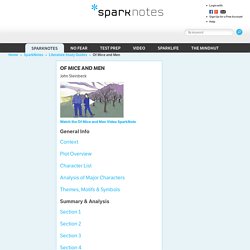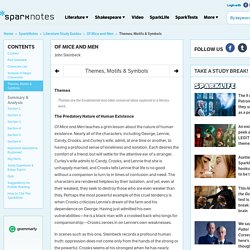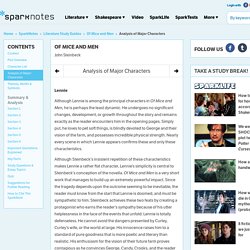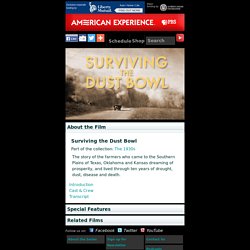

OMAM First Impressions of Crooks. OMAM First Impressions of George. OMAM First Impressions of Candy. OMAM First Impressions of Lennie. The End of the American Dream? Of Mice and Men. Point Of View by x0ellison0x, November 02, 2012 Although most sites will say that the point of view for Of Mice and Men is third-person omniscient, it is really third-person limited.

This is when the story is told from the point of view of a third-person limited narrator, who knows only the thoughts and feelings of a single character, while other characters are presented only externally. 5 Comments 84 out of 173 people found this helpful. John Steinbeck – Of Mice and Men: Chapter 2. GCSE Bitesize: Loneliness and Dreams.
The History of Mental Illness: From "Skull Drills" to "Happy Pills" The limitlessly varied personalities of human beings have fascinated both scientists and fellow members of society throughout the existence of humankind.

Of particular interest has been what happens when man’s mind turns against him, and what can be done, if anything at all, to reverse this tragic event. Attempts to treat mental illness date back as early as 5000 BCE as evidenced by the discovery of trephined skulls in regions that were home to ancient world cultures (Porter 10). Early man widely believed that mental illness was the result of supernatural phenomena such as spiritual or demonic possession, sorcery, the evil eye, or an angry deity and so responded with equally mystical, and sometimes brutal, treatments. Trephining (also referred to as trepanning) first occurred in Neolithic times. During this procedure, a hole, or trephine, was chipped into the skull using crude stone instruments. Alexander, Franz G., and Sheldon T. Blue, Amy V. Houston, R.A. Of Mice and Men: Themes, Motifs & Symbols. Themes Themes are the fundamental and often universal ideas explored in a literary work.

Of Mice and Men: Context. John Steinbeck was born in 1902 in Salinas, California, a region that became the setting for much of his fiction, including Of Mice and Men.

As a teenager, he spent his summers working as a hired hand on neighboring ranches, where his experiences of rural California and its people impressed him deeply. In 1919, he enrolled at Stanford University, where he studied intermittently for the next six years before finally leaving without having earned a degree. For the next five years, he worked as a reporter and then as caretaker for a Lake Tahoe estate while he completed his first novel, an adventure story called Cup of Gold, which was published in 1929. Critical and commercial success did not come for another six years, when Tortilla Flat was published in 1935, at which point Steinbeck was finally able to support himself entirely with his writing. Of Mice and Men: Plot Overview. Two migrant workers, George and Lennie, have been let off a bus miles away from the California farm where they are due to start work.

George is a small, dark man with “sharp, strong features.” Lennie, his companion, is his opposite, a giant of a man with a “shapeless” face. Overcome with thirst, the two stop in a clearing by a pool and decide to camp for the night. As the two converse, it becomes clear that Lennie has a mild mental disability, and is deeply devoted to George and dependent upon him for protection and guidance. George finds that Lennie, who loves petting soft things but often accidentally kills them, has been carrying and stroking a dead mouse. GCSE Bitesize: The Depression. GCSE Bitesize: The Depression. Of Mice and Men: Analysis of Major Characters. Lennie Although Lennie is among the principal characters in Of Mice and Men, he is perhaps the least dynamic.

He undergoes no significant changes, development, or growth throughout the story and remains exactly as the reader encounters him in the opening pages. Simply put, he loves to pet soft things, is blindly devoted to George and their vision of the farm, and possesses incredible physical strength. Nearly every scene in which Lennie appears confirms these and only these characteristics. Although Steinbeck’s insistent repetition of these characteristics makes Lennie a rather flat character, Lennie’s simplicity is central to Steinbeck’s conception of the novella. George Like Lennie, George can be defined by a few distinct characteristics. Of Mice and Men: Themes, Motifs & Symbols. The Migrant Experience - Voices from the Dust Bowl: the Charles L. Todd and Robert Sonkin Migrant Worker Collection, 1940-1941. A complex set of interacting forces both economic and ecological brought the migrant workers documented in this ethnographic collection to California.

Following World War I, a recession led to a drop in the market price of farm crops and caused Great Plains farmers to increase their productivity through mechanization and the cultivation of more land. This increase in farming activity required an increase in spending that caused many farmers to become financially overextended. The stock market crash in 1929 only served to exacerbate this already tenuous economic situation. Many independent farmers lost their farms when banks came to collect on their notes, while tenant farmers were turned out when economic pressure was brought to bear on large landholders. The attempts of these displaced agricultural workers to find other work were met with frustration due to a 30 percent unemployment rate. Top 10 Notes: Of Mice and Men. Racism in 1930s America: Of Mice and Men Context - OxNotes GCSE Revision.
The Great Depression. Surviving the Dust Bowl . American Experience . WGBH. Schedule Shop About the Series Sign up for Newsletter Contact Us Podcasts For Teachers Corporate Sponsorship Terms of Use Privacy Policy Additional Funding Provided By: Website ©1996-2012 WGBH Educational Foundation.

This site is produced for PBS by WGBH. Full Website. The Great Depression - Facts & Summary. Hoover, a Republican who had formerly served as U.S. secretary of commerce, believed that government should not directly intervene in the economy, and that it did not have the responsibility to create jobs or provide economic relief for its citizens.

In 1932, however, with the country mired in the depths of the Great Depression and some 15 million people (more than 20 percent of the U.S. population at the time) unemployed, Democrat Franklin D. Roosevelt won an overwhelming victory in the presidential election. By Inauguration Day (March 4, 1933), every U.S. state had ordered all remaining banks to close at the end of the fourth wave of banking panics, and the U.S. Treasury didn’t have enough cash to pay all government workers. Nonetheless, FDR (as he was known) projected a calm energy and optimism, famously declaring that “the only thing we have to fear is fear itself.”
John Steinbeck. American writer John Ernst Steinbeck Jr. (; February 27, 1902 – December 20, 1968) was an American author and the 1962 Nobel Prize in Literature winner "for his realistic and imaginative writings, combining as they do sympathetic humour and keen social perception.

"[2] He has been called "a giant of American letters,"[3] and many of his works are considered classics of Western literature.[4] Of Mice and Men: Steinbeck's Of Mice and Men. John Steinbeck's Of Mice and Men is a parable about what it means to be human. Steinbeck's story of George and Lennie's ambition of owning their own ranch, and the obstacles that stand in the way of that ambition, reveal the nature of dreams, dignity, loneliness, and sacrifice. Ultimately, Lennie, the mentally handicapped giant who makes George's dream of owning his own ranch worthwhile, ironically becomes the greatest obstacle to achieving that dream. Written by: John Steinbeck Type of Work: novel Genres: parable; Great Depression First Published: 1937 Setting: a ranch Main Characters: George Milton; Lennie Small; Candy; Curley; Curley's wife; Slim; Crooks Major Thematic Topics: nature of dreams; barriers; powerlessness; fate; Christian influences; classical influences; natural influences; loss of paradise; my brother's keeper; ephemeral nature of life Motifs: nature; loneliness; animalism versus humanity Major Symbols: characters; locations; animal imagery; George's card game; hands.
GCSE Bitesize - Of Mice and Men. BBC Bitesize - GCSE English Literature - Of Mice and Men. Of Mice and Men. Of Mice and Men is a novella[1][2] written by Nobel Prize-winning author John Steinbeck. Published in 1937, it tells the story of George Milton and Lennie Small, two displaced migrant ranch workers, who move from place to place in search of new job opportunities during the Great Depression in California, United States. Based on Steinbeck's own experiences as a bindlestiff in the 1920s (before the arrival of the Okies he would vividly describe in The Grapes of Wrath), the title is taken from Robert Burns' poem "To a Mouse", which read: "The best laid schemes o' mice an' men / Gang aft agley. " The Dust Bowl Migration: Poverty Stories, Race Stories. The Dust Bowl migration of the 1930s plays an important and complicated role in the way Americans talk about the history of poverty and public policy in their country.
For almost seventy years the story of white families from Oklahoma and neighboring states making their way to California in the midst of the Great Depression has been kept alive by journalists and filmmakers, college teachers and museum curators, songwriters and novelists, and of course historians. Although it was but one episode out of many struggles with poverty during the 1930s, the Dust Bowl migration became something of synecdoche, the single most common image that later generations would use to memorialize the hardships of that decade.
The continuing fascination with the Dust Bowl saga also has something to do with the way race and poverty have interacted over the generations since the 1930s. The Great Depression - Facts & Summary.